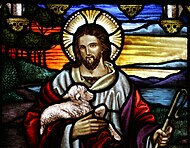History of Christianity
From Wikipedia, the free encyclopedia
For the magazine, see Christianity Today#Christian History.
"Church historian" redirects here. For LDS official church historian, see Church Historian and Recorder.
| Part of a series on |
| Christianity |
|---|
 |
Christianity emerged in the Levant (now Palestine and Israel) in the mid-1st century AD. Christianity spread initially from Jerusalem throughout the Near East, into places such as Syria, Assyria, Mesopotamia, Phoenicia, Asia Minor, Jordan and Egypt. In the 4th century it was successively adopted as the state religion by Armenia in 301, Georgia in 319,[1][2] the Aksumite Empire in 325,[3][4] and the Roman Empire in 380. It became common to all of Europe in the Middle Ages and expanded throughout the world during Europe's Age of Exploration from the Renaissance onwards to become the world's largest religion.[5] Today there are 2 billion Christians, one third of humanity.[6] Christianity divided into the Roman Catholic Church and Eastern Orthodox Church in the Great Schism of 1054. The Protestant Reformation split the Catholic Church into many different denominations. Getting all the facts Click these link now Link Now
http://en.wikipedia.org/wiki/History_of_Christianityhttp://en.wikipedia.org/wiki/History_of_Christianity
http://www.patheos.com/Library/Christianity.htmlhttp://www.patheos.com/Library/Christianity.html
http://www.religionfacts.com/christianity/index.htmhttp://www.religionfacts.com/christianity/index.htm
Christianity and Paganism
From Wikipedia, the free encyclopedia

Part of seventh century casket, depicting the pan-Germanic legend of Weyland Smith, which was apparently also a part of Anglo-Saxon pagan mythology.
From the point of view of the early Christians these religions all qualified as ethnic (or gentile, ethnikos, gentilis, the term translating goyim, later rendered as paganus) in contrast with Judaism. Since the Council of Jerusalem, the Christian apostles accepted both Jewish and pagan converts, and there was a precarious balance between the Jewish believers, insisting on the obedience to the Torah Laws by all Christians, on one hand, and Gentile Christians, developed in the gentile missionary context, on the other.
Christianity during the Middle Ages stood in opposition to the pagan ethnic religions of the peoples outside the former Roman Empire, i.e. Germanic paganism, Slavic paganism etc.
Contents
- 1 Pagan influences on Christianity
- 2 Antiquity
- 3 Christianization during the European Middle Ages
- 4 See also
- 5 References
- 6 Further reading
Pagan influences on Christianity
Further information: Hellenic philosophy and Christianity
The practices were allowed or supported by some such as Clement of Alexandria, (c. AD 150-215) who explains that "prayers are offered while looking toward sunrise in the East" because the Orient represents the birth of light that "dispels the darkness of the night" and because of the orientation of "the ancient temples."[2] or Origen (c. AD 185-254), according to whom with the East symbolizes the soul that looks to the source of light.[3]
One goal of the Reformation was to return the Christian churches to the state of early Christianity. Restorationists such as Jehovah's Witnesses continue to argue that mainstream Christianity has departed from Apostolic Christianity due, in part, to such Pagan influences.[citation needed] See also Great Apostasy.
Getting all the facts. Click on this link now

No comments:
Post a Comment